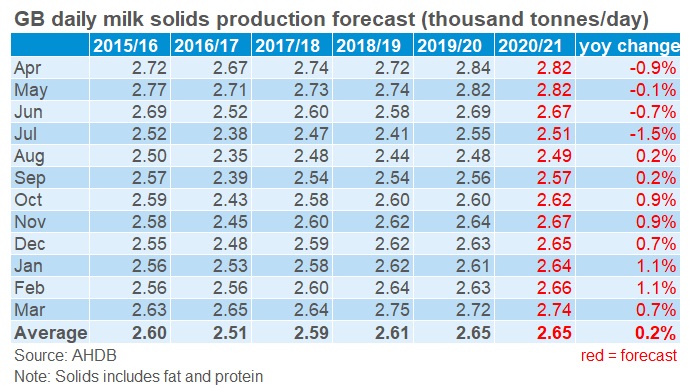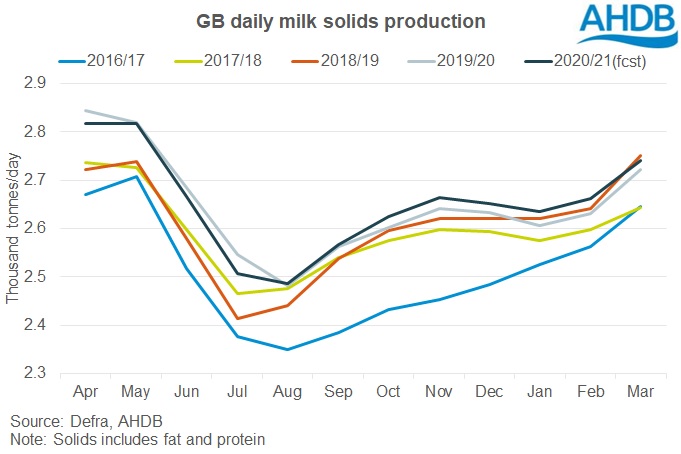What does our production forecast look like for milk solids?
Thursday, 23 April 2020
By Kat Jack
When it comes to milk supply, the solids content of the milk – in particular how much fat and protein is produced – is the real key factor for much of the dairy industry, as it affects how much product they can make from the milk. This is important even for milk destined for the liquid milk market, as the excess cream left over from standardisation is an important source of extra income for the processor.
Therefore, in addition to our milk production forecast, and our milk solids production data, we have produced a milk solids forecast, using historic trends to project how much milk solids (fat and protein) could be produced in 2020/21.
Improving genetics push up solids content
There are multiple factors affecting fat and protein, with volume produced and feeding regimen more likely to vary from year to year. However underneath this, there is a long-term trend of increasing solids production that comes from improved genetics and the changing breed makeup of the national herd. We recently analysed how herd genetics could account for a 0.08% increase in butterfat content between the 2014/15 and 2018/19 seasons, or 0.02 percentage points a year. In the same time period, average protein content improved by 0.04%, or 0.01 percentage points a year.
By combining averages of historic data with adjustments to account for genetic improvement, we can project future milk solids contents.
Milk solids production forecast 2020/21
Our March GB milk production forecast predicted that both 2019/20 and 2020/21 production would total 12.52bn litres (365 day equivalent). However, our milk solids forecast predicts that there will be a 0.2% year-on-year increase in milk solids production, thanks to that steady genetic improvement.


How might coronavirus affect solids production?
One major consideration for our forecasts is that they are based on calculations made in the early days of the UK’s response to coronavirus, when there was not enough information to fully account for the virus’ impact in the projections.
In recent weeks, there have been multiple reports of farmers being told to reduce their volumes if possible. Lowering yields is generally expected to increase fat and protein percentages. However, the methods used to achieve this can have varying effects on milk solids: culling low performing cows may raise them, but cutting back or changing feed could drop them, particularly protein.
A good example of what might happen if volumes are cut is the 2016/17 season, when farmers drastically reduced volumes off the back of extremely low milk prices. If we adjust the fat and protein figures to account for genetic improvement, the 2016/17 season then has the highest average fat content and lowest average protein content of the last 5 seasons (all adjusted).
Even now it is difficult to predict the exact level of impact coronavirus will have on next years’ milk production, but with these forecasts we will have a baseline to compare against as the data comes in.
Sign up to receive the latest information from AHDB.
While AHDB seeks to ensure that the information contained on this webpage is accurate at the time of publication, no warranty is given in respect of the information and data provided. You are responsible for how you use the information. To the maximum extent permitted by law, AHDB accepts no liability for loss, damage or injury howsoever caused or suffered (including that caused by negligence) directly or indirectly in relation to the information or data provided in this publication.
All intellectual property rights in the information and data on this webpage belong to or are licensed by AHDB. You are authorised to use such information for your internal business purposes only and you must not provide this information to any other third parties, including further publication of the information, or for commercial gain in any way whatsoever without the prior written permission of AHDB for each third party disclosure, publication or commercial arrangement. For more information, please see our Terms of Use and Privacy Notice or contact the Director of Corporate Affairs at info@ahdb.org.uk © Agriculture and Horticulture Development Board. All rights reserved.


